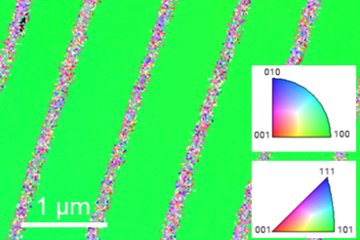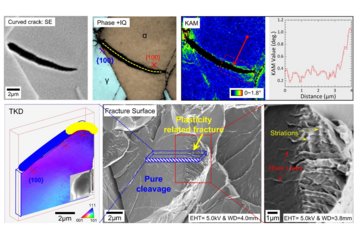All genres
921.
Journal Article
Rolling and recrystallization textures of bcc steels. Steel Research 62 (12), pp. 567 - 575 (1991)
922.
Book
Crystal Plasticity Finite Element Methods in Materials Science and Engineering. Wiley-VCH, Weinheim (2010), 197 pp.
923.
Book
Computational Materials Engineering – An Introduction to Microstructure Evolution. Academic Press, Elsevier, USA (2007), 360 pp.
924.
Book
Continuum Scale Simulation of Engineering Materials Fundamentals - Microstructures - Process Applications. WILEY-VCH, Weinheim (2004), 855 pp.
925.
Book
Computational Materials Science - The Simulation of Materials Microstructures and Properties. Wiley-VCH (1998), 402 pp.
926.
Book Chapter
Iron-rich High Entropy Alloys. In: High-Performance Ferrous Alloys, pp. 389 - 421 (Ed. Rana, R.). Springer Nature Switzerland, Cham, Switzerland (2021)
927.
Book Chapter
Spectral Solvers for Crystal Plasticity and Multi-physics Simulations. In: Handbook of Mechanics of Materials, pp. 1347 - 1372 (Eds. Hsueh, C.-H.; Schmauder, S.; Chen, C.-S.; Chawla, K. K.; Chawla, N. et al.). Springer, Singapore (2019)
928.
Book Chapter
Recovery and Recrystallization: Phenomena, Physics, Models, Simulation. In: Physical Metallurgy: Fifth Edition, Vol. 1, pp. 2291 - 2397. Elsevier Inc., New York, NY, USA (2014)
929.
Book Chapter
Interface segregation in advanced steels studied at the atomic scale. In: Microstructural Design of Advanced Engineering Materials, pp. 267 - 298 (Ed. Molodov, D. A.). Wiley-VCH Verlag GmbH & Co. KGaA, Weinheim, Germany (2013)
930.
Book Chapter
Multi‐scale Modelling of a Biological Material: The Arthropod Exoskeleton. In: Materials Design Inspired by Nature: Function Through Inner Architecture (CHAPTER 9), pp. 197 - 218 (Eds. Fratzl, P.; Dunlop, J.W.C.; Weinkamer, R.) (2013)
931.
Book Chapter
Ab Initio Guided Design of Materials. In: Structural Materials and Processes in Transportation, pp. 481 - 495 (Eds. Lehmhus, D.; Busse, M.; Herrmann, A. S.; Kayvantash, K.). Wiley-VCH Verlag GmbH & Co. KGaA, Weinheim, Germany (2013)
932.
Book Chapter
Crystal Plasticity Modeling. In: Microstructural Design of Advanced Engineering Materials, 3, pp. 41 - 57 (Ed. Molodov, D. A.). Wiley-VCH Verlag GmbH Co. KGaA, Weinheim (2013)
933.
Book Chapter
Hierarchical modeling of biological nanocomposites. In: Mechanics of Nanomaterials and Nanotechnology, pp. 199 - 224 (Eds. Kavardzhikov, V.; Parashkevova, L.; Baltov, A.). Institute of Mechanics - BAS, Sofia, Sofia, Bulgaria (2012)
934.
Book Chapter
Chitin in the exoskeletons of arthropoda: From ancient design to novel materials science. In: Chitin, pp. 35 - 60 (Ed. editor), N. S. G. (.). Springer, Germany (2011)
935.
Book Chapter
Anwendung der Textur-Komponenten-Kristallplastizitäts-FEM für die Simulation von Umformprozessen unter Berücksichtigung des Texturgradienten. In: Prozessskalierung, Strahltechnik, Tagungsband des 2. Kolloquiums Prozessskalierung im Rahmen des DFG Schwerpunktprogramms Prozessskalierung, Vol. 27, pp. 157 - 166 (Ed. Vollertsen, F.). BIAS-Verlag, Bremen (2005)
936.
Book Chapter
Drowning in data - A viewpoint on strategies for doing science with simulations. In: Handbook of Materials Modeling, pp. 2687 - 2693 (Ed. Yip, S.). Springer, The Netherlands (2005)
937.
Book Chapter
Recrystallization Simulation by use of Cellular Automata. In: Handbook of Materials Modeling, pp. 2173 - 2203 (Ed. Yip, S.). Springer, Netherlands (2005)
938.
Book Chapter
How do 10^10 crystals co-deform. In: Weitab vom Hookeschen Gesetz -- Moderne Ansätze der Ingenieurpraxis großer inelastischer Deformationen metallischer Werkstoffe (Eds. Kollmann, F. G.; G., G.; Akademie der Wissenschaften und der Literatur, Mainz, Germany). Franz Steiner Verlag, Stuttgart, Germany (2005)
939.
Book Chapter
Cellular, Lattice Gas, and Boltzmann Automata. In: Continuum Scale Simulation of Engineering Materials (Eds. Raabe, D.; Roters, F.; Bariat, F.; Chen, L.-Q.; Wiley-VCH). Wiley-VCH, Weinheim (2004)
940.
Proceedings
Proceedings of the 2nd High Mangenese Steels Conference 2014 (2nd HMnS). 2nd High Mangenese Steels Conference 2014 (2nd HMnS), Aachen, Germany, August 31, 2014 - September 04, 2014. RWTH Aachen University, Aachen, Germany (2014), 484 pp.











